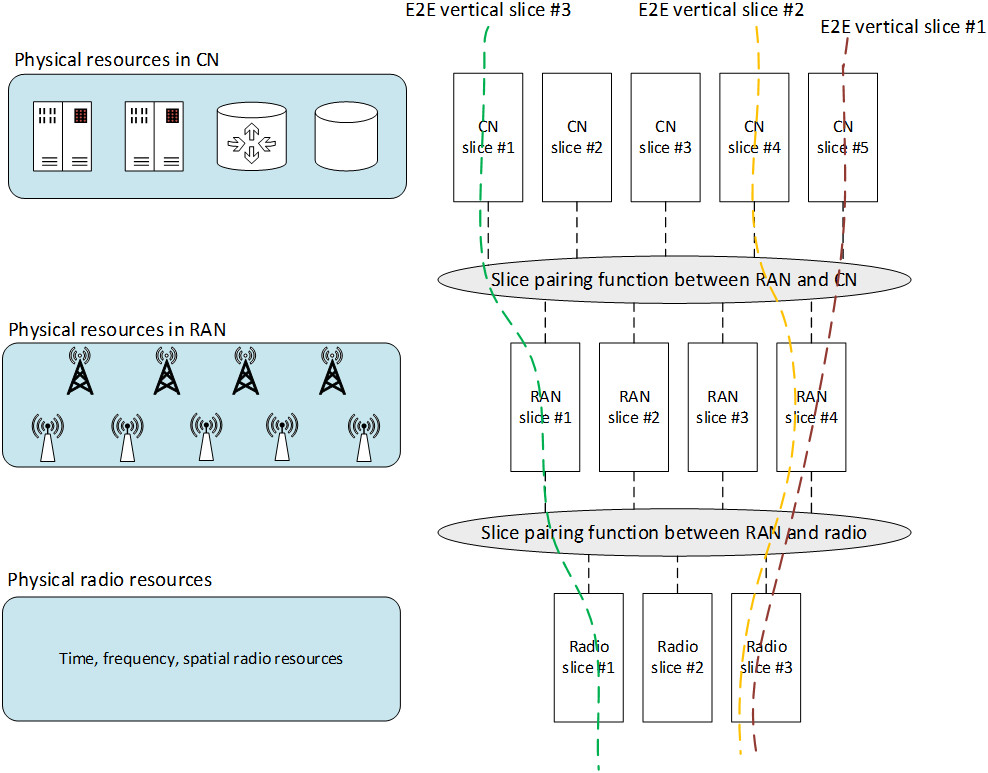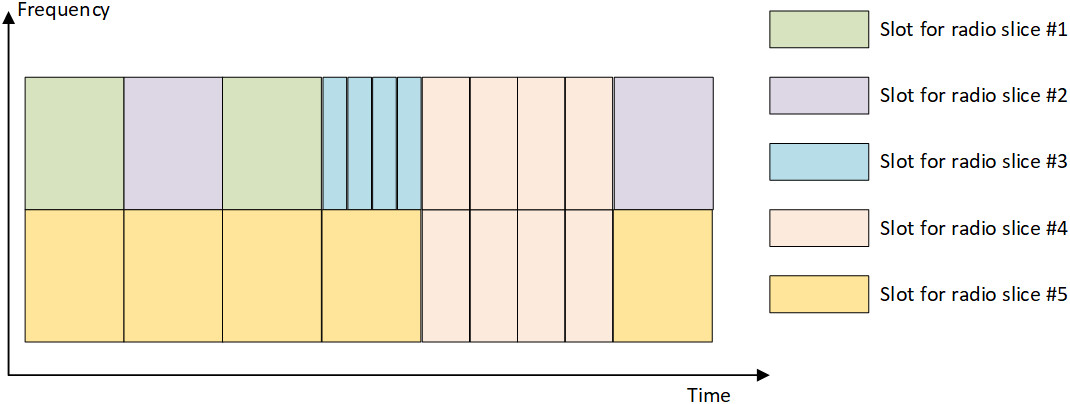Radio Slicing
Qian (Clara) Li (clara.q.li@intel.com), Geng Wu (geng.wu@intel.com), Apostolos (Tolis) Papathanassiou (apostolos.papathanassiou@intel.com), and Udayan Mukherjee (udayan.mukherjee@intel.com), Intel Corporation, USA
IEEE Softwarization, December 2017
Generally speaking, slicing techniques create self-contained logical systems from a common pool of physical resources (including computing, communication, storage, etc.). It is enabled by virtualization techniques and advances in computation and communication capabilities. Examples of slicing include vertical network slicing for different services/applications or groups of users, and horizontal edge computing slicing for computing offloading to augment device capability [1]-[3].
Motivated by the need to support diverse services and applications with flexibility, scalability and low cost, network slicing is considered as one of the key features of 5G and is developed from Core Network (CN) to Radio Access Network (RAN) to radio link. From CN and RAN perspective, slicing segregates traffic of each of the services/applications/user groups, practically avoiding or dramatically simplifying a traditional QoS engineering problem. From the radio perspective, new radio slices are created to fulfil communication requirements that cannot be achieved by scaling of the existing radio slices. An end-to-end network slice could include one CN slice, one or a few RAN slices and one or a few radio slices. For example, a CN slice that provide internet of things (IoT) services could have multiple RAN slices each to provide certain RAN capabilities, such as low power wide range access, low latency high reliability access, etc. A user equipment (UE) could connect to one or more network slices at the same time, as illustrated in Figure 1.
Figure 1 Illustration on E2E vertical network slicing
The normative specification work on network slicing is currently on-going (as of the time the article is written) in 3GPP [4]-[14]. From CN and RAN perspective, the focus has been on defining the slice identifiers, the slice selection and admission procedures, network function decoupling to enable flexible deployment of network slices, and network slice management and security. From radio link perspective, the focus is on the air interface design for each of the radio slices to meet the corresponding requirements, i.e., for the requirements that cannot be achieved by scaling of the existing radio slice air interfaces, new radio slice air interface are designed.
In fact, LTE already has radio slicing development to enable some non-mobile broadband (MBB) services. Examples include radio slices for Machine Type Communication (MTC), narrow band internet of things communication (NB-IOT) and vehicular communication (V2X). However, as LTE air interface was primarily developed for MBB service, the new radio slices often have to compromise performance to comply with LTE framework.
In 5G, the new radio (5G NR) is designed to be forward compatible, i.e., the air interface is provisioned for future addition of new radio slices. Mechanisms to ensure forward compatibility include:
- Flexible resource allocation, scheduling and HARQ framework,
- Flexible duplexing modes,
- Flexible numerologies,
- Bandwidth part contained operation.
The resource allocation and transmission scheduling framework in 5G NR as defined in [13]-[14] enables flexible multiplexing of radio slices. UEs in one radio slice are informed of the radio resources used by the radio slice, while regard radio resources used by other radio slices as unknown or reserved. Transmission can be scheduled in the unit of slot or in the unit of a few symbols in a slot, therefore allowing high transmission flexibility. Asynchronous hybrid automatic repeat request (HARQ) is supported, where depending on the UE processing capability, flexible HARQ-ACK timing can be configured.
5G NR supports flexible duplexing, where the transmission direction (i.e., downlink or uplink) of a slot in a paired spectrum can be dynamically indicated in the downlink control information of the slot. Flexible duplexing eliminates scheduling restrictions and design complexity caused by static duplexing operation, making it easier to flexibly multiplex radio slices.
5G NR supports multiple numerologies with subcarrier spacing scaling according to kHz. The symbol duration is thus scaled accordingly. From base station perspective, different numerologies can be multiplexed in time and frequency, which enables flexible multiplexing of radio slices of different numerologies. Bandwidth part contained operation allows UEs to operate within a part of the system bandwidth. The control and data transmission will be contained within the bandwidth part the UEs are configured with. This mechanism helps in reducing UE processing complexity and power consumption. It also facilitates radio slice based operation – a slice can only operate within the bandwidth part configured for the radio slice and thus can be self-contained.
Figure 2
3GPP is working on developing the first release of 5G NR specification with Release 15 planned for non-standalone operation (e.g., NR tight interworking with LTE). The primary focus is on enhanced MBB (eMBB). New radio slices are expected to be added in 3GPP future releases to enable new use cases and fulfil other 5G requirements, such as ultra-Reliable-Low-Latency Communication (URLLC), massive MTC (mMTC), V2X, device to device (D2D) communication, etc. The forward compatible design enables flexible addition of new radio slices under a unified 5G NR framework.
References
[1] NGMN Alliance: "Description of Network Slicing Concept", 2015. http://www.ngmn.org/publications/technical.html
[2] 5G Americas, “Network slicing for 5G networks and services”, Nov. 2016
[3] Q. Li, G. Wu, A. Papathanassiou, U. Mukherjee “An end to end network slicing framework for 5G wireless communication systems”, arXiv: 1608.00572, https://arxiv.org/abs/1608.00572
[4] 3GPP TS 23.501, “System architecture for the 5G system”, ver. 1.4.0, Sep. 2017
[5] 3GPP TS 22.261, “Service requirements for next generation new services and markets”, ver. 16.1.0, Sep. 2017
[6] 3GPP TR 33.811, “Study on security aspect of 5G network management slicing”, Sep. 2017
[7] 3GPP TS 28.530, “Management of network slicing in mobile network; Concepts, use cases and requirements”, ver. 0.1.0, Sep. 2017
[8] 3GPP TR 28.801, “Telecommunication management; Study on management and orchestration of network slicing for next generation network”, ver. 15.0.0, Sep. 2017
[9] 3GPP TS 38.300, “NR; Overall description; Stage-2”, ver. 1.1.1, Oct. 2017
[10] 3GPP TS 38.413, “NG-RAN; NG application protocol”, ver. 0.3.0, Sep. 2017
[11] 3GPP TS 38.423, “NG-RAN; Xn application protocol”, ver. 0.3.0, Sep. 2017
[12] 3GPP TS 38.300, “NR; NR and NG-RAN overall description”, ver. 2.0.0, Dec. 2017
[13] 3GPP TS 38.213, “NR; Physical layer procedures for control”, ver. 2.0.0, Dec. 2017
[14] 3GPP TS 38.214, “NR; Physical layer procedures for data”, ver. 2.0.0, Dec. 2017
 Dr. Qian (Clara) Li is a principle engineer with the next generation and standards division of Intel. Her research interests include radio access network, information theory, and communication theory. Since joining Intel in Sep. 2012, she has been working on 5G communications system design and standardization in sub-6 GHz and mmWave bands. Dr. Li has published more than 40 papers in international journals and conferences and 2 book chapters. She served as symposium co-chair, technical committee member and reviewer for several IEEE conferences and journals.
Dr. Qian (Clara) Li is a principle engineer with the next generation and standards division of Intel. Her research interests include radio access network, information theory, and communication theory. Since joining Intel in Sep. 2012, she has been working on 5G communications system design and standardization in sub-6 GHz and mmWave bands. Dr. Li has published more than 40 papers in international journals and conferences and 2 book chapters. She served as symposium co-chair, technical committee member and reviewer for several IEEE conferences and journals.
 Dr. Geng Wu is an Intel Fellow and the chief technologist for Intel wireless standards and technologies. He leads Intel's fifth-generation (5G) wireless standards and technology development, works extensively with global research community and ecosystem partners. Dr. Wu’s current research interests include 5G mobile computing and communication platforms, future generation network architectures and devices, mmWave channel modeling, new air interface design and performance evaluation, and cross-layer optimization for future mobile services and applications.
Dr. Geng Wu is an Intel Fellow and the chief technologist for Intel wireless standards and technologies. He leads Intel's fifth-generation (5G) wireless standards and technology development, works extensively with global research community and ecosystem partners. Dr. Wu’s current research interests include 5G mobile computing and communication platforms, future generation network architectures and devices, mmWave channel modeling, new air interface design and performance evaluation, and cross-layer optimization for future mobile services and applications.
 Apostolos (Tolis) Papathanassiou is a Senior Principal Engineer with the Next Generation and Standards (NGS) organization of the Intel Client and Internet of Things Businesses and Systems Architecture Group (CISA). He is responsible for LTE PHY and MAC standardization and has been leading different 5G technology development and standardization activities. He is the 5GAA Working Group 4 (Standards and Spectrum) Chairman and member of the WWRF (Wireless World Research Forum) Steering Board. He has more than 50 scientific contributions to international journals, conferences, and books since 1994, more than 20 awarded patents/patent applications in 3G (TDSCDMA and WCDMA), 4G (WiMAX, LTE), 5G and Wi-Fi (IEEE 802.11a/g/n) wireless communications systems since 1996, and more than 100 contributions to wireless standardization bodies such as 3GPP, IEEE 802.11, IEEE 802.16, and WiMAX Forum since 1999. Previously at Intel, he led multiple standardization efforts in ITU-R and IEEE 802.16/WiMAX Forum. Before joining Intel, Apostolos worked on multiple-antenna PHY techniques and algorithms for 3G, satellite, and Wi-Fi wireless systems.
Apostolos (Tolis) Papathanassiou is a Senior Principal Engineer with the Next Generation and Standards (NGS) organization of the Intel Client and Internet of Things Businesses and Systems Architecture Group (CISA). He is responsible for LTE PHY and MAC standardization and has been leading different 5G technology development and standardization activities. He is the 5GAA Working Group 4 (Standards and Spectrum) Chairman and member of the WWRF (Wireless World Research Forum) Steering Board. He has more than 50 scientific contributions to international journals, conferences, and books since 1994, more than 20 awarded patents/patent applications in 3G (TDSCDMA and WCDMA), 4G (WiMAX, LTE), 5G and Wi-Fi (IEEE 802.11a/g/n) wireless communications systems since 1996, and more than 100 contributions to wireless standardization bodies such as 3GPP, IEEE 802.11, IEEE 802.16, and WiMAX Forum since 1999. Previously at Intel, he led multiple standardization efforts in ITU-R and IEEE 802.16/WiMAX Forum. Before joining Intel, Apostolos worked on multiple-antenna PHY techniques and algorithms for 3G, satellite, and Wi-Fi wireless systems.
 Udayan Mukherjee is an Intel Fellow in the Data Center Group and chief technologist for network infrastructure at Intel Corporation. He leads technology and platform development related to wireless radio access and core networks, including Cloud-RAN, virtual RAN, base stations, mobile edge platforms, as well as gateways and packet core solutions. Mukherjee is also responsible for establishing new growth areas for Intel in the telecommunications market segment, a role that includes developing technologies and optimizations for telecom platforms designed for software-based networking and network function virtualization, developing wireless-specific intellectual property, and leading Intel’s 5G wireless network technology and platform development.
Udayan Mukherjee is an Intel Fellow in the Data Center Group and chief technologist for network infrastructure at Intel Corporation. He leads technology and platform development related to wireless radio access and core networks, including Cloud-RAN, virtual RAN, base stations, mobile edge platforms, as well as gateways and packet core solutions. Mukherjee is also responsible for establishing new growth areas for Intel in the telecommunications market segment, a role that includes developing technologies and optimizations for telecom platforms designed for software-based networking and network function virtualization, developing wireless-specific intellectual property, and leading Intel’s 5G wireless network technology and platform development.
Editor:
 Chris Hrivnak is a Sr. Member of the IEEE and The Photonics Society. He is also a member of the IEEE Life Sciences Community, the IEEE Software Defined Networks (SDN) Community and the IEEE Internet Technology Policy Community and has participated in the IEEE Experts in Technology and Policy (ETAP) Forum.. He graduated from Baldwin Wallace University and completed varied coursework at Cleveland State, Case Western Reserve, Gould Management Education Center, McKinsey, Hughes R&D Productivity, UT-Dallas, Tulane Law and Pepperdine Graziadio. Broad range of interests including but not limited to augmented intelligence, autonomous systems, additive manufacturing, information & communications technologies (ICT), life sciences, dark physics, etc.
Chris Hrivnak is a Sr. Member of the IEEE and The Photonics Society. He is also a member of the IEEE Life Sciences Community, the IEEE Software Defined Networks (SDN) Community and the IEEE Internet Technology Policy Community and has participated in the IEEE Experts in Technology and Policy (ETAP) Forum.. He graduated from Baldwin Wallace University and completed varied coursework at Cleveland State, Case Western Reserve, Gould Management Education Center, McKinsey, Hughes R&D Productivity, UT-Dallas, Tulane Law and Pepperdine Graziadio. Broad range of interests including but not limited to augmented intelligence, autonomous systems, additive manufacturing, information & communications technologies (ICT), life sciences, dark physics, etc.
Subscribe to IEEE Softwarization
Join our free SDN Technical Community and receive IEEE Softwarization.
Article Contributions Welcomed
Download IEEE Softwarization Editorial Guidelines for Authors (PDF, 122 KB)
If you wish to have an article considered for publication, please contact the Managing Editor at sdn-editor@ieee.org.
Past Issues
IEEE Softwarization Editorial Board
Laurent Ciavaglia, Editor-in-Chief
Mohamed Faten Zhani, Managing Editor
TBD, Deputy Managing Editor
Syed Hassan Ahmed
Dr. J. Amudhavel
Francesco Benedetto
Korhan Cengiz
Noel Crespi
Neil Davies
Eliezer Dekel
Eileen Healy
Chris Hrivnak
Atta ur Rehman Khan
Marie-Paule Odini
Shashikant Patil
Kostas Pentikousis
Luca Prete
Muhammad Maaz Rehan
Mubashir Rehmani
Stefano Salsano
Elio Salvadori
Nadir Shah
Alexandros Stavdas
Jose Verger





